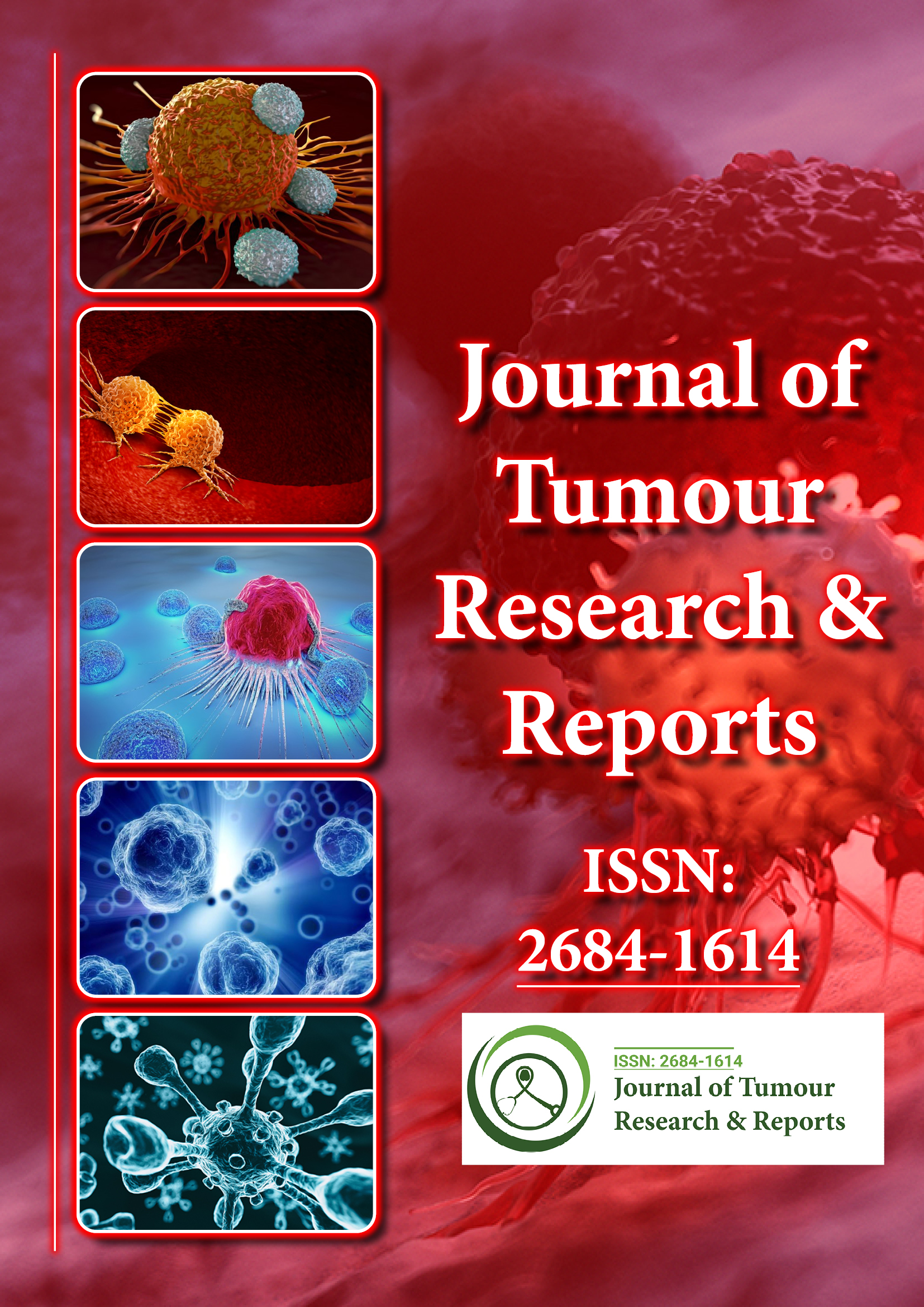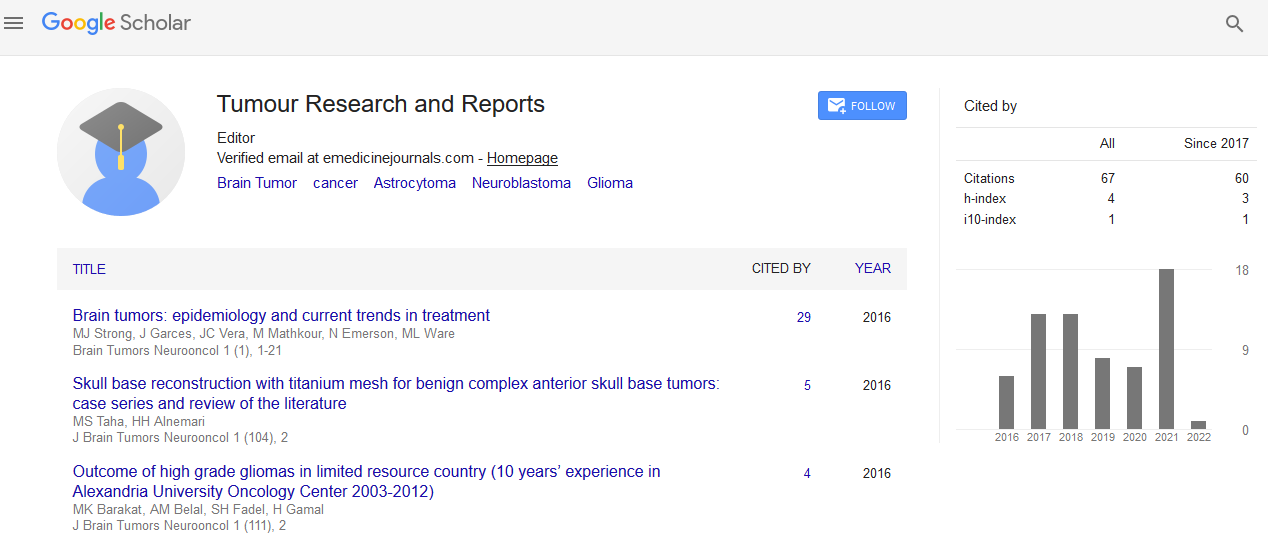Indexed In
- RefSeek
- Hamdard University
- EBSCO A-Z
- Google Scholar
Useful Links
Share This Page
Journal Flyer

Open Access Journals
- Agri and Aquaculture
- Biochemistry
- Bioinformatics & Systems Biology
- Business & Management
- Chemistry
- Clinical Sciences
- Engineering
- Food & Nutrition
- General Science
- Genetics & Molecular Biology
- Immunology & Microbiology
- Medical Sciences
- Neuroscience & Psychology
- Nursing & Health Care
- Pharmaceutical Sciences
Short Communication - (2023) Volume 8, Issue 3
The Role of DNA Damage Response Genes in Osteosarcoma Progression
Leo Sylvie*Received: 11-Aug-2023, Manuscript No. JTRR-23-23202; Editor assigned: 14-Aug-2023, Pre QC No. JTRR-23-23202 (PQ); Reviewed: 28-Aug-2023, QC No. JTRR-23-23202; Revised: 04-Sep-2023, Manuscript No. JTRR-23-23202 (R); Published: 11-Sep-2023, DOI: 10.35248/2684-1614.23.8:203
Description
Osteosarcoma, a rare and aggressive bone cancer that primarily affects adolescents and young adults, poses a significant challenge in the field of oncology. Despite advancements in cancer research and treatment modalities, the prognosis for osteosarcoma patients remains suboptimal, highlighting the need for a deeper understanding of the molecular mechanisms driving this malignancy [1]. One such mechanism that has gained increasing attention is the role of DNA Damage Response (DDR) genes in osteosarcoma development and progression.
The DDR and cancer
The DNA damage response is a complex cellular system that safeguards the genome's integrity by detecting and repairing DNA damage caused by various factors, such as radiation, chemicals, and cellular processes [2]. This intricate network involves a multitude of genes and pathways that work in concert to ensure DNA repair, cell cycle regulation, and apoptosis in the event of irreparable damage.
DDR genes in osteosarcoma
Osteosarcoma is characterized by genomic instability and a high frequency of chromosomal abnormalities, suggesting a connection between DDR gene dysfunction and the disease's pathogenesis. Several studies have explain the role of DDR genes in osteosarcoma development and progression, making them attractive targets for therapeutic intervention [3].
Key DDR genes in osteosarcoma
TP53: The TP53 gene, which encodes the p53 protein, is often referred to as the "guardian of the genome" due to its pivotal role in maintaining genomic stability. Mutations in TP53 are common in osteosarcoma and are associated with a poor prognosis [4]. Dysfunctional p53 can lead to impaired DNA repair and increased resistance to apoptosis, enabling cancer cells to evade cell cycle checkpoints.
ATM : The ATM (Ataxia-Telangiectasia Mutated) gene is significant for detecting DNA double-strand breaks and initiating the repair process [5]. In osteosarcoma, alterations in ATM have been linked to impaired DNA repair mechanisms, contributing to genetic instability.
BRCA1 and BRCA2: These genes are well-known for their involvement in breast and ovarian cancers but also play a role in osteosarcoma. BRCA1 and BRCA2 are essential for homologous recombination, a DNA repair mechanism. Mutations in these genes can compromise the repair of DNA damage, increasing the risk of tumorigenesis [6].
CHEK2: The CHEK2 gene encodes the CHK2 protein, which acts as a mediator in the DDR pathway. Mutations in CHEK2 have been identified in osteosarcoma cases, leading to defects in cell cycle regulation and DNA repair [7].
Therapeutic implications
Understanding the role of DDR genes in osteosarcoma has access to the potential therapeutic strategies. Targeting DDR pathways can sensitize cancer cells to DNA-damaging agents, enhancing the efficacy of chemotherapy and radiation therapy [8]. PARP (Poly ADP-Ribose Polymerase) inhibitors, for instance, have shown potential in clinical trials for various cancers, including those with DDR deficiencies.
Furthermore, identifying specific DDR gene mutations in osteosarcoma patients can help tailor treatment approaches. Personalized medicine, which aims to match treatments to an individual's genetic profile, may lead to more effective and less toxic therapies for osteosarcoma [9].
Challenges and future directions
While the role of DDR genes in osteosarcoma is increasingly recognized, several challenges remain. One major problem is the heterogeneity of osteosarcoma, which can make it difficult to pinpoint consistent DDR gene alterations across all cases.
Future directions in osteosarcoma research should focus on elucidating the intricate interplay between DDR genes and other molecular pathways driving the disease. This comprehensive understanding will be helpful for the development of novel targeted therapies and combination treatments that can improve patient outcomes [10].
As it continue to utilize the complexities of DDR genes in osteosarcoma, personalized treatment approaches and innovative therapies hold potential for improving the prognosis of those affected by this aggressive bone cancer. While challenges remain, the pursuit of a deeper understanding of DDR genes in osteosarcoma is a significant step toward more effective treatments and, ultimately, better outcomes for patients.
Conclusion
Osteosarcoma presents a formidable challenge in the branch of cancer, especially for adolescents and young adults. The intricate web of DDR genes and pathways has emerged as a significant area of investigation in understanding the molecular mechanisms behind this aggressive bone cancer. Genomic instability, a hallmark of osteosarcoma, appears to be closely linked to dysregulation of DDR genes, with TP53, ATM, BRCA1, BRCA2, and CHEK2 taking center stage.
References
- Ji H, Kong L, Wang Y, Hou Z, Kong W, Qi J, et al. CD44 expression is correlated with osteosarcoma cell progression and immune infiltration and affects the Wnt/β-catenin signaling pathway. J Bone Oncol. 2023;41:100487.
[Crossref] [Google Scholar] [PubMed]
- Shen Y, Xie Q, Wang Y, Liang J, Jiang C, Liu X, et al. Design, synthesis and anti-osteosarcoma activity study of novel pyrido [2, 3-d] pyrimidine derivatives by inhibiting DKK1-Wnt/β-catenin pathway. Bioorg. Chem. 2023:106848.
[Crossref] [Google Scholar] [PubMed]
- van Ewijk R, Herold N, Baecklund F, Baumhoer D, Boye K, Gaspar N, et al. European standard clinical practice recommendations for children and adolescents with Primary and Recurrent osteosarcoma. EJC Pediatr. Oncol. 2023:100029.
- Huang L, Zeng X, Liang W, Chen J, Zhong C, Cai W, et al. Dissecting the role of lactate metabolism LncRNAs in the progression and immune microenvironment of osteosarcoma. Transl. Oncol. 2023;36:101753.
[Crossref] [Google Scholar] [PubMed]
- Wang W, Chang J, Ruan H, Sun X, Zhao F, Zhao P, et al. Intratibial osteosarcoma growth and pulmonary metastasis inhibition by HIPPO signaling pathway-induced photodynamic therapy. Mater. Des. 2023;233:112269.
- Gianferante DM, Moore A, Spector LG, Wheeler W, Yang T, Hubbard A, et al. Genetically inferred birthweight, height, and puberty timing and risk of osteosarcoma. Cancer Epidemiol. 2023:102432.
[Crossref] [Google Scholar] [PubMed]
- Qiu X, He H, Zeng H, Tong X, Zhang C, Liu Y, et al. Integrative transcriptome analysis identifies MYBL2 as a poor prognosis marker for osteosarcoma and a pan-cancer marker of immune infiltration. Genes Dis. 2023.
- Chen JY, Wang YQ, Lin HF, Yu LY, Lin XZ, Lin XH, et al. Ultrasensitive electrochemical biosensor based on triple signal amplification strategy for detection of serum cf-miR-181b: A possible biomarker related to osteosarcoma’s early diagnosis and chemotherapy monitoring. Sens. Actuators B Chem. 2023;395:134505.
- Zhang Z, Wu H, Xing Y, Zhang X, Wang J, Chen B. CircBBS9 accelerates the malignant progression of osteosarcoma through sponging miR-485-3p/HMGB1 axis. J Orthop. 2023.
[Crossref] [Google scholar] [PubMed]
- Jin J, Cong J, Lei S, Zhang Q, Zhong X, Su Y, et al. Cracking the code: Deciphering the role of the tumor microenvironment in osteosarcoma metastasis. Int. Immunopharmacol. 2023;121:110422.
[Crossref] [Google Scholar] [PubMed]
Citation: Sylvie L (2023) The Role of DNA Damage Response Genes in Osteosarcoma Progression. J Tum Res Reports. 8:203.
Copyright: © 2023 Sylvie L. This is an open access article distributed under the terms of the Creative Commons Attribution License, which permits unrestricted use, distribution, and reproduction in any medium, provided the original author and source are credited.

